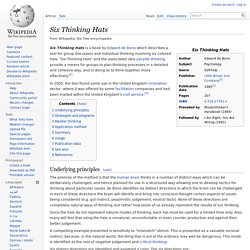

Learn How to Think Different(ly) - Jeff Dyer and Hal Gregersen. By Jeff Dyer and Hal Gregersen | 10:24 AM September 27, 2011 In the Economist review of our book, The Innovator’s DNA, the reviewer wondered whether genius-level innovators such as Marc Benioff, Jeff Bezos, and Steve Jobs challenge the idea that working adults can really learn how to think differently and become innovators.

We don’t think so. Remember, it was Steve Jobs who jump-started the now-famous “Think Different” advertising campaign as a way to inspire consumers and recharge Apple’s innovation efforts. It worked. Reflecting back on the campaign, Jobs said “The whole purpose of the ‘Think Different’ campaign was that people had forgotten what Apple stood for, including the employees.”
Reams of relevant research (including our own) proves Jobs right. But neither Steve Jobs nor Apple nor any other high-profile innovator or company has a corner on the think-different market. Take Gavin Symanowitz, whom we recently met in South Africa. Just do It. Shake it up. Repeat. Creative problem solving. Thinking Methods: Creative Problem Solving. They further divided the six stages into three phases, as follows: 1.

Exploring the Challenge (Objective Finding, Fact Finding, and Problem Finding), Generating Ideas (Idea Finding), and Preparing for Action (Solution Finding and Acceptance Finding). Description: Since the arrival of the now classical Osborn-Parnes structure, any number of academic and business entities have re-sorted and renamed the stages and phases of what we now call the Creative Problem Solving Process (CPS).
However, the originators' fundamental approach remains in tact. The Creative Problem Solving Institute of Buffalo, New York, has finessed the Osborn-Parnes process to include a divergent and a convergent stage within each of the six stages. In his 1988 book, Techniques of Structured Problems, Arthur B. Mess FindingData FindingProblem FindingIdea FindingSolution Finding Where to Learn CPS. Thinking Methods. Six Thinking Hats. Six Thinking Hats is a book by Edward de Bono which describes a tool for group discussion and individual thinking involving six colored hats.

"Six Thinking Hats" and the associated idea parallel thinking provide a means for groups to plan thinking processes in a detailed and cohesive way, and in doing so to think together more effectively.[2] Underlying principles[edit] The premise of the method is that the human brain thinks in a number of distinct ways which can be deliberately challenged, and hence planned for use in a structured way allowing one to develop tactics for thinking about particular issues. de Bono identifies six distinct directions in which the brain can be challenged.
In each of these directions the brain will identify and bring into conscious thought certain aspects of issues being considered (e.g. gut instinct, pessimistic judgement, neutral facts). Since the hats do not represent natural modes of thinking, each hat must be used for a limited time only. Summary[edit] EDWARD DE BONO'S AUTHORISED WEBSITE - HOME PAGE. Lateral thinking. Lateral thinking is solving problems through an indirect and creative approach, using reasoning that is not immediately obvious and involving ideas that may not be obtainable by using only traditional step-by-step logic.

The term was coined in 1967 by Edward de Bono. [1] According to de Bono, lateral thinking deliberately distances itself from standard perceptions of creativity as either "vertical" logic (the classic method for problem solving: working out the solution step-by-step from the given data) or "horizontal" imagination (having many ideas but being unconcerned with the detailed implementation of them). Methods[edit] Critical thinking is primarily concerned with judging the true value of statements and seeking errors. Lateral thinking is more concerned with the "movement value" of statements and ideas. Random Entry Idea Generating Tool: The thinker chooses an object at random, or a noun from a dictionary, and associates it with the area they are thinking about. See also[edit] Realistic Lateral Thinking Puzzles. Lateral Thinking Puzzles, unlike most puzzles, are inexact.

In a sense, they are a hybrid between puzzles and storytelling. In each puzzle, some clues to a scenario are given, but the clues don't tell the full story. Your job is to fill in the details and complete the story. Obviously, there is usually more than one answer to any given puzzle, but, in general, only one solution is truly satisfying. You can try solving these puzzles on your own -- that's certainly a legitimate way to go about this -- but usually you can have more fun if you involve other people. Warning: For some reason, these puzzles have a tendency to be rather morbid. The scenarios given on this page are realistic, if unlikely.